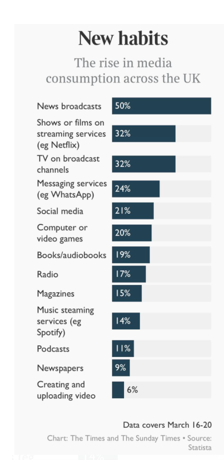An Audience-First Approach For Brands Is More Relevant Than Ever: Surviving The COVID-19 Era
We’re living in dystopian times. Who would have thought the greatest threat of humanity in 2020 is not war, but rather a virus that has spread globally, causing thousands of deaths and despair to millions.
Apart from the human casualties, the COVID-19 crisis has caused (or the ‘worst’ is yet to come) a financial crisis with millions of workers around the world losing their jobs or experiencing uncertainty due to the inability of some industries to adjust.
For better or worse, the advertising industries and more so digital, have demonstrated their ability to be resilient, taking their operations to the employees’ homes and aiming at continuing doing so at a ‘business as usual’ pace. It hasn’t been easy for most; parents had to juggle work and childcare at the same time, employees living in a flat-share had to share their ‘home’ workplace with several people, whilst others who live alone, had to find ways of balancing out social distancing and human contact through digital communications.
Having recently become a necessity, the perception of working from home not being as efficient is slowly changing for advertising agencies and quite frankly, what keeps us alive as an industry. So, in a sense, that exact ability to quickly respond to crises and adjust to change, create a responsibility to offer guidance and support to clients’ businesses that have been directly impacted by the coronavirus outbreak or simply are not sure how to behave in the advertising space. Fortunately, sooner or later, this crisis will end but before it does, how businesses react to it while it exists, will define their ability to survive and contribute to the global economic sphere.
For advertising in particular, though media consumption behaviour has slightly shifted due to the fact that we are staying at home more than we used to, humans will be humans, meaning the aspects of behavioural science that define receptiveness of communications will remain the same. The environment in the media space will change, being almost overwhelmed with news and COVID-19 updates (like this one!) yet initial insights by some media owners demonstrate people are still receptive to advertising if not more.

A recent report by Twitter (‘Adjusting to Life in a COVID-19 world), demonstrated what users are doing during the time of self-isolation and how receptive they are to brands:
- What are they talking about? – 13% of all Tweets are related to COVID-19. There is still a great deal of conversation about other things
- What are they doing? – Significant rise amongst our users in Gaming, Online shopping, cooking, streaming and listening to music
- Do they want to hear from brands? – Yes, the majority of Twitter UK users want to hear from brands at this time, as it gives them a sense of ‘normality’
What people are doing more or less of:
Doing more of:
1 in 5 Twitter users are playing more video games
- 16% Twitter users are playing on their phone more
- Over a third of Twitter users (37%) are spending more time on social
media
- 22% are doing more online shopping
- 18% are cooking more from scratch
- 30% are using streaming services more
- 27% are Facetiming/video calling friends and family more
- A quarter (24%) are doing more laundry and chores
- 25% are reading more
- 23% are listening to the radio/music more
Doing less of:
- 43% are going out to the shops less
- 69% are eating/drinking out less
- 36% are engaging with their community less
Similarly, Pinterest users in the UK:
- They’re searching for solutions. They are looking for ideas of combining childcare & working from home, recipes, home exercise ideas.
- They’re still planning for future moments. We’ve seen a 2x increase in searches for Irish recipes for St. Patrick’s Day and a 70% increase in Easter-related queries.
- They’re seeking positivity. Searches for “keeping calm” and “staying calm” increased 31% in the last two weeks vs. the two weeks prior. And people are keeping their spirits up with searches like “quarantine funny” rising, too.”
Having stated the above, it is a global crisis and brands need to be quite careful of how they craft their communications in order to talk to consumers. Following insights and trends on audience behaviour is key to determine how to do that, as we are experiencing times of unprecedent change and nothing can be taken for granted. On the other hand, brands who were hit most by this crisis (eg. travel, hospitality, luxury) should think about where the opportunity lies and what is the appropriate way to tap into untapped territories. People want to hear from brands and the latter will have to respond to that demand. More than ever, a user-centric approach has become essential for communication strategies for brands, whilst also the key to their survival and growth.





